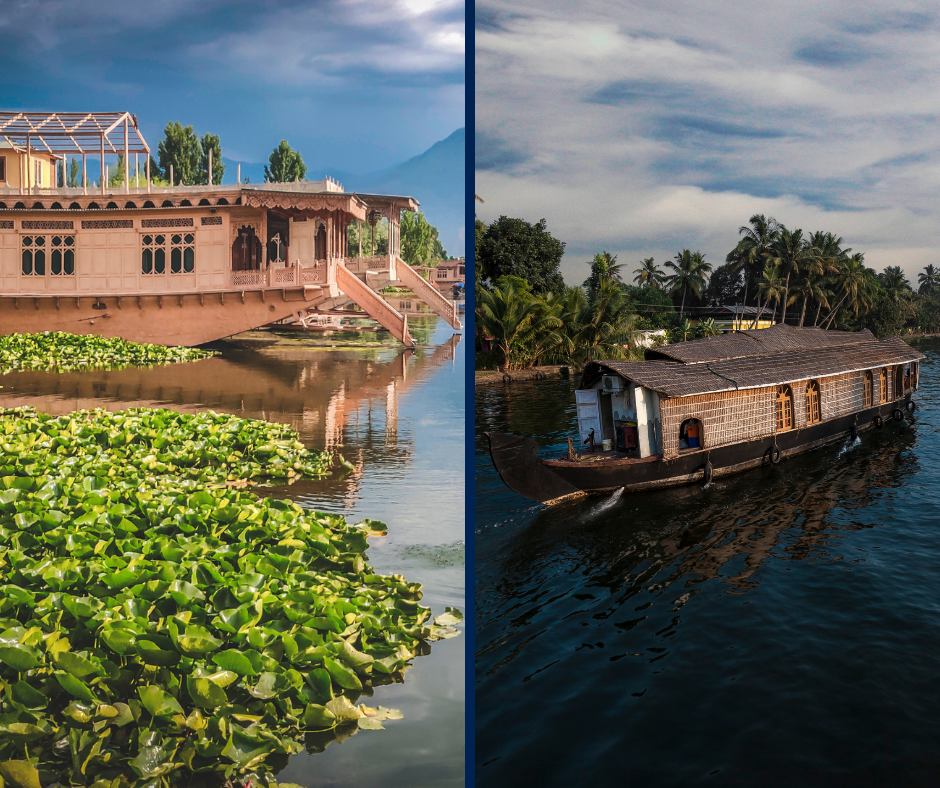Imagine floating gently on serene waters, embraced by the whispers of nature and the elegance of tradition. But are all houseboats the same? The answer may surprise you. Welcome to the tale of two regions, one legacy, and entirely different experiences—Kerala and Kashmir.
In a world where travel is more than a journey—where it becomes a story, a culture, a heartbeat—houseboats offer a profound escape. Yet, there’s a stark contrast in what you’ll experience in the backwaters of Kerala and the still waters of Dal Lake in Kashmir. And if you think one houseboat is just like another, this is your wake-up call.
A Journey Through Culture, Not Just Water
Kashmir’s houseboats are poetry carved in wood. Born of necessity and brilliance during colonial times when foreigners were not allowed to own land, these floating wooden homes became a legacy of British influence mingled with Kashmiri art. These are not boats in motion. They are moored palaces — anchored yet alive with handcrafted walnut wood carvings, Persian-style rugs, intricate papier-mâché ceilings, and chandeliers that whisper history with every flicker.
Step inside a Kashmiri houseboat, and you’re transported into a royal era. Each houseboat is a statement — often stretching up to 80 feet long with multiple bedrooms, dining areas, and a veranda that opens onto the soul of Dal or Nigeen Lake. Here, mornings begin with saffron kahwa served on a shikara, and days pass by watching snow-capped peaks dance in the reflection of still waters.
Kerala’s houseboats, on the other hand, are an ode to transformation — modern-day adaptations of the kettuvallams once used to carry rice across the backwaters. Unlike the stationary Kashmiri houseboats, Kerala’s vessels are designed to move — meandering through coconut groves, paddy fields, and sleepy village life. The hull is made of jackfruit tree wood tied with coir ropes, and the thatched roofs provide an earthy embrace to travelers looking to escape urban noise.
The interiors of Kerala houseboats are modest yet comfortable, with an open layout meant for breezy afternoons, local seafood delights, and immersive journeys through the culture-rich waterscapes of Alappuzha, Kumarakom, or Kollam. It’s not just about where you stay — it’s about where the boat takes you.
More Than Tourism: A Window Into Two Souls of India
Choosing between these two isn’t just a travel decision — it’s a choice between immersion and nostalgia, movement and stillness, earthiness and elegance. Kashmir’s houseboats are like ancient poetry frozen in time. Kerala’s are rhythmic songs that travel with the breeze. Both are deeply spiritual, yet they speak different emotional languages.
Where in Kashmir, every houseboat is a heritage symbol handed down through generations, in Kerala, houseboats represent the ingenuity of evolving tradition, blending tourism with sustainability and local economy. In Kashmir, you feel cradled by the Himalayas, in Kerala, you’re embraced by the tropics. One offers a royal stillness, the other a meditative motion.
The Urgency to Preserve, Protect, and Experience
But here’s the reality many overlook — both are under threat.
The once-pristine Dal Lake battles pollution and encroachment. Aging houseboats crumble under regulatory neglect, while families who’ve preserved this heritage for centuries face dwindling support. In Kerala, climate change and reckless commercialization threaten the fragile ecosystem of the backwaters. The coir, bamboo, and wood-based boats require mindful maintenance — yet fewer artisans remain to pass on the craftsmanship.
As travelers, we must go beyond just witnessing these experiences. We must become guardians of them.
Final Thought
Don’t let these floating worlds drift past you. In the silent sway of a houseboat, you don’t just travel—you transform.
The question is—will you choose calm or culture, warmth or wonder, South or North? Or will you embrace both and discover a richer, deeper India?

